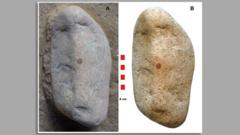Scientists have uncovered what they claim to be the oldest complete human fingerprint in Spain, suggesting that Neanderthals possibly engaged in artistic practices. The fossilized trace is believed to have been left by a Neanderthal who used red pigment to paint a nose on a stone approximately 43,000 years ago. This significant discovery was made in the San Lázaro rock shelter located in Segovia, Spain.
Researchers argue that the positioning of the pigment marks indicates a level of abstract thinking and symbolic behavior in Neanderthals, an idea that adds depth to the ongoing discussions regarding their artistic capabilities. Study co-author, María de Andrés-Herrero, highlighted during a BBC interview that excavation efforts began five years prior and the notable stone was found beneath 1.5 meters of Neanderthal deposits in 2022.
At first glance, the team struggled to process their finding; the unique stone stood out amidst surrounding rocks due to its size and a prominent red dot that resembled a human face. Initially uncertain about the nature of the dot, further investigation confirmed it was indeed made from ochre, a natural pigment. Collaborating with Spain's scientific police enabled the team to conduct detailed analyses, ultimately identifying the fingerprint on the pebble.
Although the study examined the print, co-author and archaeologist David Álvarez Alonso noted the lack of comparison references made it challenging to definitively categorize the identity of the fingerprint. During a press conference featuring the study's updates, Spanish official Gonzalo Santonja emphasized this pebble as the oldest known object of portable art in Europe, solely painted by Neanderthals.
According to Prof de Andrés-Herrero, this finding is pivotal in understanding the symbolic capacity of Neanderthals. It marks the earliest recorded pigment-marked artifact from an archaeological context, strongly linking it to Neanderthal activity. The placement of the fingerprint conveys the notion that the art was not unintentional; rather, it suggests a deliberate act by the artist.
Moreover, the researchers found that red pigment does not occur naturally within the shelter, reinforcing the theory that it was purposefully transported there. In their publication in *Archaeological and Anthropological Sciences*, the research team presented the pebble as a potential visual symbol, affirming its status as a piece of portable art under specific contexts. The connection forged through this artifact propels discussions on the cognitive and cultural complexities of Neanderthals to new heights.
Researchers argue that the positioning of the pigment marks indicates a level of abstract thinking and symbolic behavior in Neanderthals, an idea that adds depth to the ongoing discussions regarding their artistic capabilities. Study co-author, María de Andrés-Herrero, highlighted during a BBC interview that excavation efforts began five years prior and the notable stone was found beneath 1.5 meters of Neanderthal deposits in 2022.
At first glance, the team struggled to process their finding; the unique stone stood out amidst surrounding rocks due to its size and a prominent red dot that resembled a human face. Initially uncertain about the nature of the dot, further investigation confirmed it was indeed made from ochre, a natural pigment. Collaborating with Spain's scientific police enabled the team to conduct detailed analyses, ultimately identifying the fingerprint on the pebble.
Although the study examined the print, co-author and archaeologist David Álvarez Alonso noted the lack of comparison references made it challenging to definitively categorize the identity of the fingerprint. During a press conference featuring the study's updates, Spanish official Gonzalo Santonja emphasized this pebble as the oldest known object of portable art in Europe, solely painted by Neanderthals.
According to Prof de Andrés-Herrero, this finding is pivotal in understanding the symbolic capacity of Neanderthals. It marks the earliest recorded pigment-marked artifact from an archaeological context, strongly linking it to Neanderthal activity. The placement of the fingerprint conveys the notion that the art was not unintentional; rather, it suggests a deliberate act by the artist.
Moreover, the researchers found that red pigment does not occur naturally within the shelter, reinforcing the theory that it was purposefully transported there. In their publication in *Archaeological and Anthropological Sciences*, the research team presented the pebble as a potential visual symbol, affirming its status as a piece of portable art under specific contexts. The connection forged through this artifact propels discussions on the cognitive and cultural complexities of Neanderthals to new heights.




















